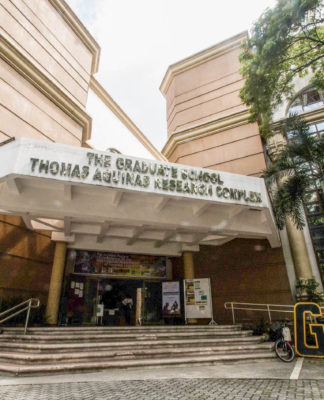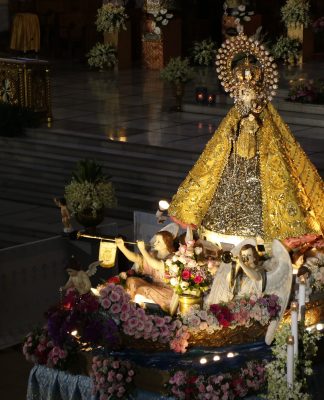TOO BAD social networking sites do not have religious applications because the digital age seems to have won over the youth, who would rather go online than spare time to pray the rosary.
According to Fr. Roland Mactal, O.P., a professor of Dogma and Mariology in the Faculty of Sacred Theology, the “commercialized” environment distracts people from praying and meditating.
“People would rather surf the Internet than meditate,” he said. “Maybe, the reason why people are not disposed to praying the rosary is because of the influence of mass media, and also of technology.”
Praying the rosary is part of Catholic tradition and is a form of expression of devotion to Mary. However, the awareness and the commitment to pray through the rosary is fading nowadays, Mactal observed.
To keep this Marian devotion alive and in line with the celebration of the Holy Rosary month and the feast of La Naval de Manila, “A Marian exhibit, Our Lady and the Saints of the Rosary,” was showcased last September 24 to October 11 at the Santisimo Rosario parish.
The collection of rare Marian images showed the resilience of the devotion, which can be traced back to the Spanish missionaries.
Some of the images were “San Alberto Magno” in polychrome wood by Navotas master carver Beto Panganiban, and the bas relief of the martyrs of China by Luis Ac-ac from Paete, Laguna. Organizers of the exhibit were parish priest Fr. Franklin Beltran, O.P. and artist Rei Nicolas, a UST College of Fine Arts and Design alumnus.
Also featured in the exhibit were the collections of Marian devotees Tom Joven, Jerome de Jesus, John Enriquez, Noel Abquilan, Jun Manahan, Dr. Norby Martinez, Fr. Aloy Aliño, Fr. Roland Castro, O.P., and Rector Fr. Rolando de la Rosa, O.P.
In addition, the colleges and faculties in collaboration with the Santisimo Rosario parish, sponsored novena masses and novena prayers.
To raise awareness about the rosary devotion, the Campus Ministry holds the year-long block rosary in more than 60 offices on campus. However, according to Assoc. Prof. Richard Pazcoguin, assistant director of Campus Ministry, only some 35 offices take turns in praying the rosary vigil every year.
“The target clientele of this (block rosary) are the administrators and their office staff,” Pazcoguin said. “Sometimes when the Virgin Mary is brought to the colleges, they (staff) take the initiative to invite a particular class to pray the rosary with them.”
A symposium on the Holy Rosary, which served as a mini recollection for students, was also conducted on top of the usual activities organized during October.
Pazcoguin said the ministry also plans to revive the project of providing a rosary for every Thomasian, particularly the freshmen.
Call for more prayers
Today, logging in to their social network accounts seem more appealing to young people than taking time for a meaningful prayer, but Mactal said the repetitive prayers in the rosary cannot be blamed for the the lack of interest among people.
“Repetition is only an aspect of the rosary,” he said. “The greater aspect is the meditation upon the lives of Jesus and Mary.”
Their impatience and restlessness show the younger generation’s lack of disposition to really pray silently and to spend time for contemplation, the Dominican father said.
Mactal emphasized that a person must have the right disposition to properly pray the rosary. Silence is necessary to connect us with the divine, he said.
He suggested that for one not to be overwhelmed by the rosary, one should start with a decade and progress from there.
Ironically, the rosary has become a popular fashion accessory. Pazcoguin said that there is no problem with that as long as it is a “genuine act of piety.” “It is important that what we show externally is symbolic of our internal disposition,” he explained.
A gift to the Thomasians
Before the University was named after St. Thomas Aquinas, it was first known as the Colegio de Nuestra Señora del Santisimo Rosario. Through this association, Mactal believed that the University is closely linked with the rosary.
“Marian devotion is a gift to be cultivated in line with UST’s quadricentennial celebration. Spiritual growth, along with other aspects, provides a holistic approach to the (celebration of our) 400th anniversary,” Mactal said.
To encourage students to pray the rosary, the Mariology expert suggested reading Biblical passages connected with the mysteries to facilitate a meaningful reflection on the lives of Jesus and Mary.
A living rosary, where each person can represent a bead, may be an interesting way to promote a unified prayer among the youth, he added.
Mactal also said that college students who lead prayers, processions, and vigils can greatly influence their younger peers to strengthen their spiritual growth.
Moreover, Mactal said the healing rosary, wherein one reflects on one’s past traumatic events as one meditates on the rosary mysteries, is effective as well. The mysteries of the rosary are related with events in one’s life (personal suffering is related with the Sorrowful Mystery, for example). Through this correlation, one realizes that Christ is present, helping one to carry one’s burdens.
“The mysteries of the rosary are intertwined with the mysteries of our lives, and through praying the rosary, we become aware that Christ is with us even in our suffering,” Mactal said. Camille Abigael P. Alcantara and Florench May C. Corpuz















